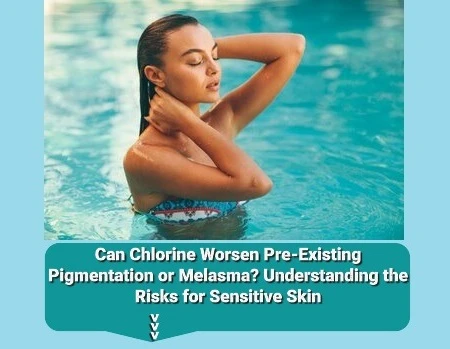Can Chlorine Worsen Pre-Existing Pigmentation or Melasma? Understanding the Risks for Sensitive Skin
Can Chlorine Worsen Pre-Existing Pigmentation or Melasma? Understanding the Risks for Sensitive Skin
Pigmentation disorders like melasma are notoriously stubborn and sensitive to environmental triggers, especially sun exposure. But another lesser-known factor that may influence skin discoloration is chlorine—commonly found in swimming pools and cleaning agents. If you’re managing melasma or hyperpigmentation, it’s natural to wonder: Can chlorine worsen these conditions? Let’s explore how chlorine affects sensitive skin and whether it can contribute to the worsening of pigmentation.
What Is Melasma and Hyperpigmentation?
Melasma is a form of hyperpigmentation that appears as symmetrical, blotchy, brown or gray-brown patches, usually on the face. It is commonly triggered by UV radiation, hormonal changes, heat, and inflammation. Hyperpigmentation, in general, refers to dark spots or patches on the skin caused by excess melanin production, which can result from acne, sun damage, or injury to the skin.
Both conditions are exacerbated by inflammation and sun exposure—two factors that may be indirectly influenced by chlorine.
How Chlorine Interacts with the Skin
Chlorine is used to disinfect water in pools and household products. While it keeps pools clean, it is also a harsh chemical that can strip the skin of its natural oils and damage the protective barrier. This can lead to dryness, irritation, and increased sensitivity, particularly for individuals with already compromised or sensitive skin.
Repeated exposure to chlorinated water can:
-
Disrupt the skin’s barrier, making it more vulnerable to UV radiation.
-
Trigger inflammation, especially in people with sensitive or reactive skin types.
-
Exacerbate existing skin conditions, including eczema, acne, and potentially pigmentation.
Can Chlorine Worsen Melasma or Pigmentation?
While chlorine doesn’t directly cause melasma or dark spots, it can indirectly worsen these conditions through the following mechanisms:
-
Increased Sensitivity to Sun: A weakened skin barrier from chlorine exposure makes skin more susceptible to UV damage, which is a major trigger for melasma and pigmentation.
-
Inflammation-Induced Pigmentation: Inflammation caused by chlorine irritation can stimulate post-inflammatory hyperpigmentation (PIH), especially in darker skin tones.
-
Dryness and Irritation: Dry, irritated skin is more prone to pigmentation issues as it heals. This is particularly concerning if chlorine exposure is frequent and prolonged.
How to Protect Your Skin from Chlorine
If you have melasma or are prone to hyperpigmentation, it’s important to minimize chlorine-related damage with the following tips:
-
Apply a barrier cream or oil (like petroleum jelly or coconut oil) before swimming to protect the skin.
-
Use a broad-spectrum sunscreen with SPF 50 daily, especially before and after swimming.
-
Rinse immediately after pool exposure to remove chlorine residue.
-
Moisturize generously with barrier-repairing ingredients like ceramides, hyaluronic acid, or niacinamide.
-
Limit time in chlorinated water or opt for saltwater or ozone-treated pools if available.
Conclusion
While chlorine doesn't directly cause melasma or pigmentation, its ability to weaken the skin barrier, cause inflammation, and increase UV sensitivity can certainly aggravate these conditions. For those managing pigmentation issues, protecting the skin from chlorine exposure is essential. Combining sun protection with post-swim skincare can help maintain a healthy barrier and prevent flare-ups of discoloration.

Related Blog
What Causes Oily Skin and Can It Be Managed Naturally? Exploring Root Causes and Gentle Solutions
Aug 2, 2025 by Admin
General
What Are the Signs That You Have Sensitive Skin? Key Symptoms to Help You Identify This Delicate Skin Type
Aug 1, 2025 by Admin
General